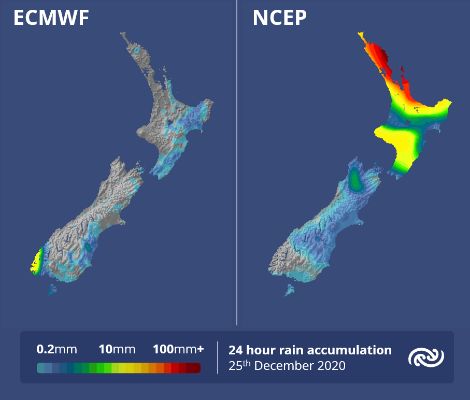Long Range Forecast For Christmas
Whether you celebrate Christmas or not, the weather on 25 December will impact the decisions of many people nationwide. If you’re planning a BBQ, heading to the beach or deciding what you will wear to work – MetService is right there alongside you.
With all the currently available information there’s a good chance that the 25th will be met with settled weather but there is a notable risk for less than ideal conditions.
MetService computer generated forecasts are now covering 25 December nationwide which can be found on metservice.com and our New Zealand Weather app.
Lewis Ferris, MetService meteorologist says, “10 days out from the big day there is still significant uncertainty revolving around the two Tropical Cyclones near Fiji and Niue so these forecasts shouldn’t be taken as ’set in stone’."
“From Sunday 20th up until the ‘big day’ is when our team of meteorologists have much more certainty about the weather systems and write detailed forecasts for our channels”
“In most cases, a 10 day forecast will alter as we get closer to the day but this should be expected as the atmosphere is an incredibly dynamic fluid which is impossible to model exactly especially when dealing with tropical cyclones, even with modern computing power,” says Ferris.
By looking at a range of deterministic and ensemble computer models we can weigh up the most impactful outcome with the most likely one. So let’s dive in:
Deterministic
computer models
Starting with deterministic
models – these provide the most probable single solution
from one computer model and give a reasonable idea out to
six days. At 10 days we are pushing the limits of their
accuracy and it really shows as the models have very
different solutions for New Zealand.
As an example, the model run by the European Centre for Medium Range Forecasts (ECMWF) has a large ridge of high pressure over New Zealand which would bring relatively settled conditions almost country wide. This is the ideal solution if you were planning to be outside on the 25th.
However, the model run in the US by the National Centers for Environmental Prediction (NCEP) brings a low pressure system close to Northland, and while it’s not a deep low it is tied up in a lot of high humidity air and would have the ability to bring periods of heavy rain from Northland down into the Bay of Plenty. Other parts of the North Island also would be in for a dose of rain while eastern and northern parts of the South Island may see some showers. This outcome is far from an ideal beach day for most.
So how do we deal with conflicting forecasts from difference models? One approach is to look at the ensemble solutions from these two models to gauge how likely one particular outcome is.
Ensemble computer models
In a
nutshell an ensemble is the same model run multiple times
with slightly different starting conditions, resulting in
slightly different forecasts in the future. This is useful
to show how likely a particular outcome is based on how many
members of the ensemble follow the same
story.
Starting again with the model from ECMWF. The deterministic idea of settled weather is well represented in many ensemble members which gives extra confidence in that outcome.
By contrast, the ensemble from NCEP shows the idea of a low to the north is pretty well represented. A situation bringing settled weather is also there but is outnumbered by the wetter outcome.
“As illustrated in the examples above the uncertainty of forecasting ten days out is very real. Weather is dynamic and fast changing especially with Aotearoa’s position in the roaring forties,” says Ferris.
As always, keep up to date with the most recent forecast and know that our meteorologists will be doing a thorough analysis from 6 days out up until the big day.



 Gordon Campbell: On What’s Wrong With The Treaty Principles Bill
Gordon Campbell: On What’s Wrong With The Treaty Principles Bill NZ National Party: National Acknowledges The Passing Of Hon Nikki Kaye
NZ National Party: National Acknowledges The Passing Of Hon Nikki Kaye Mana Mokopuna: Children And Young People Share Vital Insights On Healing From Family Violence And Sexual Violence In New Report
Mana Mokopuna: Children And Young People Share Vital Insights On Healing From Family Violence And Sexual Violence In New Report NZ Government: PM Marks One Year In Government
NZ Government: PM Marks One Year In Government Helen Clark Foundation: Helen Clark Foundation Calls For Political Action To Reduce The Prevalence Of Junk Food And Improve Health Outcomes
Helen Clark Foundation: Helen Clark Foundation Calls For Political Action To Reduce The Prevalence Of Junk Food And Improve Health Outcomes Justice Committee: Further Decisions About Submissions Process For The Principles Of The Treaty Of Waitangi Bill
Justice Committee: Further Decisions About Submissions Process For The Principles Of The Treaty Of Waitangi Bill Infrastructure New Zealand: Single Agency Needed To Coordinate Climate Adaptation And Recovery
Infrastructure New Zealand: Single Agency Needed To Coordinate Climate Adaptation And Recovery


